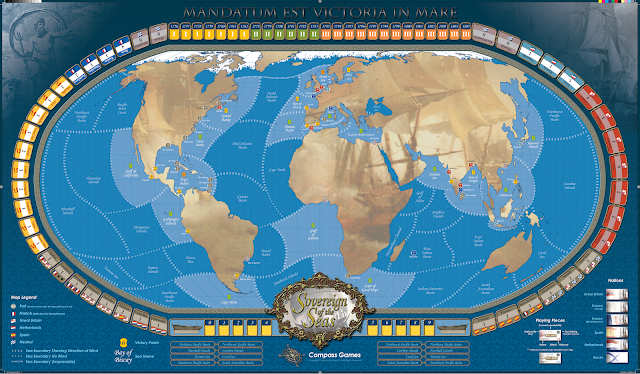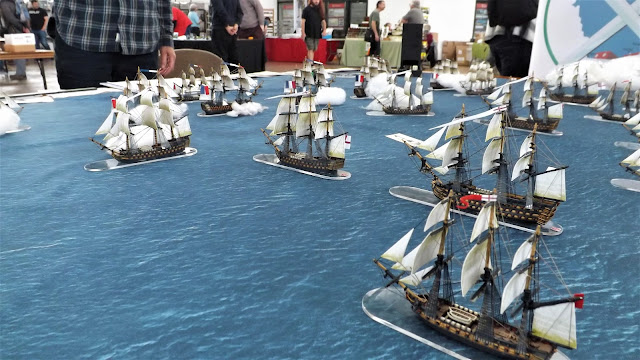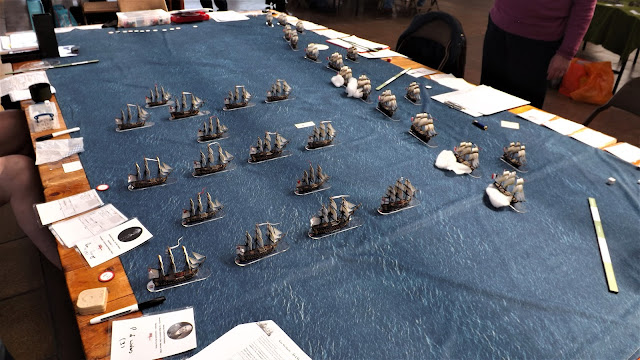Like many Age of Sail wargamers I have long mused over the idea of running a naval campaign for this period/era of the great sailing men-o-war that cruised the oceans and seas in the 18th and 19th centuries.
That musing has taken on added emphasis with my recent focus on building a rather large collection of 1:700th Napoleonic ships produced by Warlord Games which has reached a crescendo with recent large battle games recreating Trafalgar and Cape St Vincent where the effect of tens of ships filing the table top has really helped illustrate why this scale of gaming age of sail is so appealing for me.
With plans to create a Batavian Dutch fleet for a refight of the anniversary of the Battle of Camperdown later this year, my thoughts turned back to an idea that formed whilst playing the boardgame Sovereign of the Seas (SOTS) from Compass Games on Vassal with my mate Jason, to perhaps use the game as an engine for generating tabletop encounters that we could playout to resolve our map based encounters, and have the context of the wider global naval conflict going on in the background, a theme I touched on in my post back in February reviewing my recent Vassal gaming back then, link below.
 |
| JJ's Wargames - Vassal Gaming Too Date |
If you are not familiar with SOTS, the game follows in the footsteps of the classic Avalon Hill Games, Victory in the Pacific and War at Sea with the sweep of the war at sea encompassing enemy fleets moving to various sea zones aiming to dominate a key area at the end of a play phase, or to destroy key forces in the process or simply to deny control of a given area from them.
Obviously this period differs substantially from the twentieth century conflicts in that the ships rely on sail power rather than oil fired turbines and reconnaissance and scouting is limited to the mark one eyeball with no resort to radar or aircraft to help find fleets in the briny expanse.
 |
| This stunning map in SOTS forms the backdrop to our tabletop games and allows the global war situation to be outlined beforehand. |
This is where the glorious map in SOTS comes in, a work of art in its own right, with transition between various sea zones reliant on prevailing winds that impact on fleets and squadrons movement allowances as they attempt to reach any given area.
Should two opposing squadrons find each other and end up in the same area at the end of a given turn, representing one year of the war at sea, then a battle is generated and in the board game the fleets of ships progress to a battle board to fight out the action which we decided to take to the tabletop instead. Only one of the opposing squadrons can remain in a given area indicating victory in battle and victory points gained to one side or the other.
Obviously this is a top line description of our campaign set up that has needed a few additions to better model interception attempts and linking up the table game damage results to ships with how SOTS would model them, but the board game sits very well in the background to what is more important to a tabletop gamer, namely the context for our models battling away on the table.
So back in February, I enrolled fellow naval gaming enthusiasts from the DWG to let me know if they would be interested in playing the games this campaign generated and then Jason (Commanding the French & Combined Allied Navies (Spain and the Batavian Dutch) and myself running the British got together to play out turn one 1793 on Vassal using SOTS, which generated the following situation for that year.
The French are attempting to control sea areas by getting into them and avoiding being intercepted thus gaining the VPs for the area, the Grand Banks off Halifax being an example in the briefing map sent to the players seen below. This effectively simulates the French and Allies mission tactics and their effect on British commerce and thus the effect on Britain to wage war.
The British on the other hand are solely focussed on control of the sea lanes, which means destroying and taking out enemy ships that effectively stops their attempts to interfere with British commerce and support for European allies waging war on the French Republic and her own allies.
The frigates, in our additional rules can also affect interceptions by British patrolling squadrons, with British frigates able to also influence intercept outcomes.
Should opposing frigates end up in an area as the sole occupants we intend to fight single ship engagements to determine if the Allies can garner any victory points for attempted commerce raiding or to see if they are thwarted by the British frigate effort.
The victory point schedule can be seen below, also part of the players briefing, to help illustrate the importance of our given battle, with 5VP for control of the Bay of Bengal and a French frigate in the area that would grab a further 3VP should the British fleet be driven off and beaten in the upcoming battle, but with more VP's for struck and sunk French ships attainable by the British that could easily outweigh the occupational gains already in French hands with the control of the Grand Banks.
| The respective fleet organisations for our Battle of Madras as revealed in SOTS at the conclusion of 1793 |
With March and April taken up with holidays away and other games booked at club, the first opportunity to fight our game was May 7th at yesterday's Legionary show and the picture below illustrates the set up adopted by our respective commanders, David (Commodore Rosily) and Jack (Admiral Howe) ably supported by Steve (Commodore Allemand) and Bob (Commodore Troubridge).
Howe on seeing the French deployed downwind in line awaiting the British fleet ordered his three squadrons into three columns with Commodore George Berkely aboard the Prince of Wales 98-guns in the right column, himself aboard his flagship the Royal George 100-guns and Commodore Troubridge, an up and coming future star in British naval ranks, should he survive this encounter, aboard the Prince George 98-guns.
 |
| The British Order of Battle showing the damage results from our first battle of the campaign |
Howe was leading the cream of the British fleet which included the exemplary HMS Culloden known for her speed, tacking ability and superb firing together with seven other elite crewed vessels, perhaps offset by rumblings among the crews about pay and conditions that the prospect of action seemed to have quelled, at least for the moment.
Whilst Steve (Commodore Allemand) was enjoying his first game of Kiss Me Hardy commanding the rear of the French line, David was having an equal amount of fun pouring on the hurt at the head of the French line as the leading British ships started to close on the French van to be greeted with a seeming succession of French three decked first rates, relatively unscathed and very much up for the fight.
However Jack didn't need to worry about morale checks as his boarding attempts by his two third rates were repulsed and sensing weakness David ordered his first rates to counter-board seeing both British third rates beaten in three turns striking on the fall of their lower decks and leaving the British attack stymied.
The French East Indies Squadron was commanded by the best of their captains, appointed commodores in the wake of the Revolutionary purges of more senior officers and those that had fled to supporters of the Bourbon regime, with the commander, François Étienne de Rosily-Mesros, already earmarked for promotion to Rear-Admiral provided of course that he produced the results from this key mission to disrupt British trade from the Indies.
 |
| The French Order of Battle, illustrating how well a defensive battle they fought when compared with the British order of battle seen above |
Rosily commanded a powerful force which included the two 122-gun flagships Marseille and Montagne supported by the two 110-gun first rates Republique and Terrible and included the elite crewed Bucentaure and Victoire, only offset by the need to complete several crews with untrained landsmen that left the third rates Censeur, Genereux, Patriote and Desaix struggling to perform even the most basic requirements of maintaining their station in the line of battle.
After setting up the French players rolled for each ship in the line to see if it was off station before the game commenced.
 |
| Battle is joined as the French open fire on the British columns |
The British plan of attack was predicated on the Nelsonian 'breaking of the line' tactic, which Howe had attempted historically at the Glorious First of June in 1794, a manoeuvre that amply illustrated the lack of understanding many British captains still had for this manoeuvre, this early in the French Revolutionary War, demonstrated by the inability of several captains in that battle to comply with their commander's order and thus simply opt to engage to windward or worse still stand off to windward whilst engaging at long to medium range.
I thus informed Howe (Jack) that I would require a die roll from each British ship attempting to break the French line with an average British crew having a 50% chance of complying and with failure seeing them turn and engage from the windward side.
 |
| The Terrible 110-guns opens her broadside on the rigging of Culloden 74-guns causing the elite third rate to lose her mizzen mast on the run in. |
This advice caused a flurry of signals across the British fleet that would see them seemingly to decide to attack from windward and engage closely whilst also running the gauntlet of French fire as they closed the range.
Needless to say this tactic neither gained the advantage of attempting to break the French line with the associated chance to bow and stern rake their opponents as they broke through to engage to leeward and prevent any escapes as they closed in to board, whilst also reaping all the disadvantages of the hail of fire heaped upon their rigging and hulls as they closed in bow on and unable to fire back in response.
 |
| The British columns can be seen turning away to larboard as they run down the French line having suffered the battering from the French on the approach. |
Meanwhile, the French fleet did what it has the potential to be quite good at when forced on to the defensive, downwind in line of battle, that is to blaze away at extreme and long range inflicting ever increasing amounts of damage to the lead British ships rigging with the effectiveness of that fire amply demonstrated by the Patriote, which despite its poor-landlubber crew managed to inflict a couple of hits at extreme range, but scoring a '2' on the d10 critical hit die, got to roll for that hit immediately adding another five hits and managing to bring down the mizzen mast of the Culloden.
 |
| As the columns of Howe and Berkely tangle with the French van the leading French third rates wear round to support the French flagship |
If that was not bad enough, having dropped the Culloden out of the column to bring her broadside to bear to provide covering fire to the following Prince George 98-guns, Commodore Troubridge's flagship, that took up the lead, she to was greeted with an accurate fusillade from the rearmost French ships that managed to bring down her mizzen as well.
 |
| Marlborough 74-guns (22), the struck Fortitude 74-guns (12) the Republique 110-guns and the Prince of Wales 98 guns (3) entangled at the close of battle |
Perhaps the decision to pin them in place by bringing the British third rates, Fortitude 74-guns and Monarch 74-guns was not such a good idea, even though there elite crews gave them almost parity when it came to the boarding action die rolls.
On closing to short range both British ships were greeted again with unerringly accurate French fire causing both to suffer 'High Officer Casualties' in critical hit die rolls that didn't bode well for any follow up morale checks.
 |
| Victoire 74-guns and Prince George 98-guns exchange compliments |
 |
| Goliath 74-guns brings up the rear of Howe's centre column as the action hots up ahead |
The British fleet, despite the loss of two of their 74s, were no where near fleet break point, but conversely neither were the French, and the majority of their ships were in a much better state of repair.
With our game fast approaching its end the British tried to salvage some pride from this decidedly one sided affair by throwing ships at those locked in grapples, together with Troubridge placing the Prince George at point blank range on the stern of the Victoire aiming to rake the French third rate and take her out of the battle in one broadside, only to see the Frenchman get the move chit that put her at medium range and thus limited her damage to the worst suffered by any of the French ships.
Then to rub salt in British wounds the following Patriote 74-guns sniped the Prince George with her bow chasers, again scoring an improbable critical hit that knocked down the second-rate's mainmast which just about summed up the day for the British.
Despite the melee of ships at the end of the game, the final damage tally seen on the orders of battle above indicate that the French during our game had definitely got the better of things and although unlikely to be able to keep hold of their British prizes were very likely to have more and bigger ships still able to contest the area compared to the British and thus I was compelled to ignore my role as British First Sea Lord and award the victory to Commodore's Rosily and Allemand which sees the French gain a useful lead in the campaign with 17 VP, and an interesting retirement interview for Lord Howe on his return to England.
Kiss Me Hardy performed to its usual levels of fast moving action with plenty of cameo moments of drama as masts fell and colours were struck and I would thank David, Steve, Jack and Bob for playing the game in our usual fashion with much fun had by all.
I should also mention a thanks to all those folks who stopped by to chat with myself and the players as the game progressed throughout the day. It's always more fun to share these games with others so thankyou to everyone who stopped to say hello.
Legionary is back in the wargames show calendar and made for a great venue for this our first campaign game.
More anon
JJ










No comments:
Post a Comment